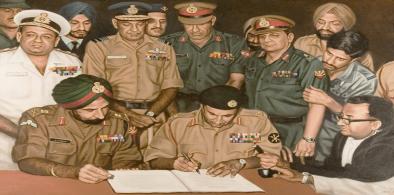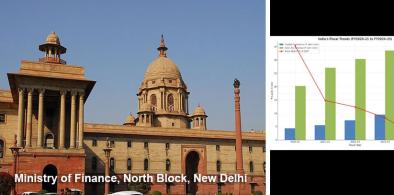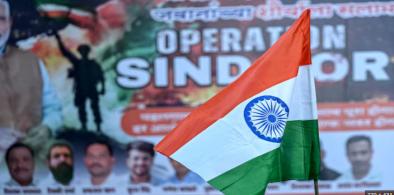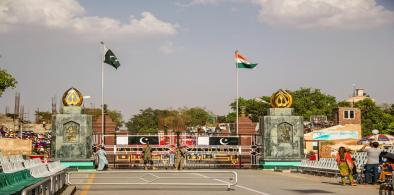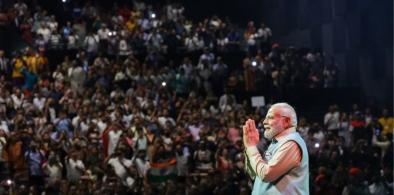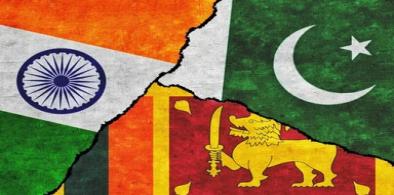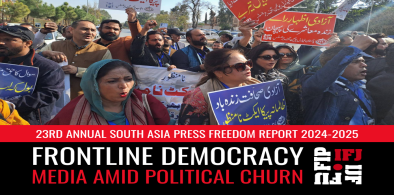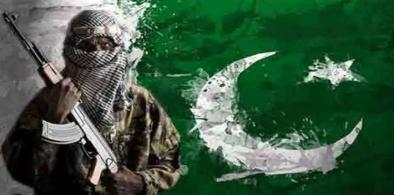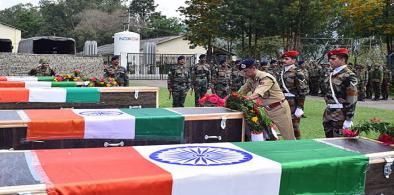One high-profile case involving a Bangladeshi actress made this painfully clear. When private videos of her were leaked by a former fiance, the fallout was swift—but not for the man who betrayed her. The scrutiny, the mockery, the moral judgment—it all landed squarely on her shoulders. The technology was modern; the public reaction was anything but.
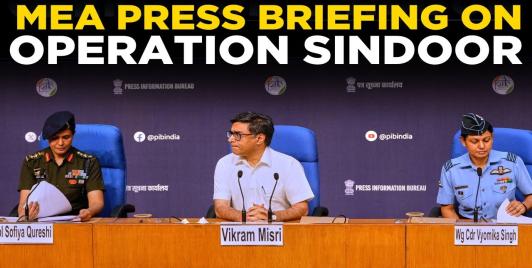
Establishing Narrative and Perception Dominance in Modern Conflict: A National Security Imperative for India
A nation's power today is judged not just by its military or economy but also by the credibility, speed, and resonance of its narrative. As adversaries evolve their hybrid warfare strategies to target public opinion, social trust, and international perception, India must develop a narrative response architecture that is anticipatory rather than reactive
From Dhaka to Balochistan: Pakistan's Recurring Tragedies That It Draws No Lessons From
Flashforward from 1971 to 2025 to a Pakistan facing almost the same kind of problems that it was facing in 1971: same intrusions of military in public affairs, same hopelessness, same corruption, same or more inflation and, most importantly, the same threat of rebellion.
Is India Chasing A Mirage? Theatrical Diplomacy No Substitute For Strategic Power
The warm reception given to Pakistan's Army Chief in Washington is more than symbolic. It indicates Washington's strategic calculation—that India, despite its rhetoric, is becoming a more problematic partner. Washington, while not forsaking India, is hedging its bets. Its embrace of Pakistan is a backup plan.
India’s Fiscal Scorecard 2.0: Can It Turn Potential Into Performance In Decade's Second Innings?
India’s states play an outsized role in public spending accounting for nearly +/- 60% of total government expenditure. However, their fiscal health varies greatly across pan India. As someone closely observing both macroeconomic trends and grassroots governance models, I notice a growing divide between states that follow prudent fiscal practices and those still trapped in populist spending cycles.
Bangladesh Not Sliding Into Radicalism: Indian Media Peddling False Narratives, Will Harm Ties
Indian media’s portrayal of Bangladesh as sliding into extremism also threatens to derail valuable regional cooperation initiatives. South Asia is one of the least integrated regions in the world, despite shared histories and cultural ties. Any attempt to isolate Bangladesh or provoke fear-mongering narratives does not serve the interests of the region’s people. India and Bangladesh have enjoyed largely cordial relations in recent years; however such baseless media narratives risk fraying this relationship
A Looming Water Crisis for Bangladesh: Will Dhaka-Delhi Renegotiate Ganga Water Treaty?
Amid reported Indian reluctance, Dhaka has turned to Beijing for a 50-year master plan on river management. This has raised alarms in Delhi, especially as the proposed infrastructure is near the strategically sensitive Siliguri Corridor, a 22-kilometer-wide stretch connecting India to its northeastern states. Dhaka's pivot towards Beijing may ultimately disrupt the regional balance of power.
Unlimited lessons from a limited war: Questions that need to be asked
Trump equated India and Pakistan when he spoke on the ceasefire, erasing the genuinely-earned and the increasingly well-accepted de-hyphenation of two neighbours that were born at the same time but have walked very different paths – India as a secular nation that is an economic powerhouse while Pakistan as a failing democracy that faces economic uncertainty. This re-hyphenation is a sorry picture because it dwarfs India and keeps the nation confined and limited
War is not a solution: India and Pakistan's priorities lie in dealing with human suffering, building on core strengths
So, instead of becoming two adversaries and wasting money and men on terrorism and war, both nations should focus on education, health, employment and on building nation specific infrastructure projects. Today, the breed of strong global leaders with ethics and morality is fast disappearing. War between nations is exploited to boost weapon trade.
How Modi’s India is Rewriting the Rules of Warfare and Reshaping Regional Dynamics
The consequences are dangerous. Both sides now feel compelled to respond forcefully, fearing that restraint might be perceived as weakness. Pakistan, already grappling with economic and political instability, faces increased pressure to retaliate. For India, any future terror attack is likely to provoke immediate military response. The threshold for conflict has lowered significantly—creating a volatile environment where a single militant operation could ignite full-scale war.
The India-Pakistan Conflict and Its Impact on Sri Lanka
Sri Lanka often finds itself navigating a diplomatic tightrope. While it shares strong cultural, economic, and historical ties with India, it also engages with Pakistan through trade, defense training, and political goodwill. The India-Pakistan rivalry sometimes limits Sri Lanka’s foreign policy options and restricts deeper ties with one country for fear of antagonizing the other.
Operation Sindoor marked a paradigm shift in India’s counter-terrorism posture
Pakistan, on the global stage, once again struggled to maintain credibility. In a widely viewed CNN interview, Pakistan’s Defence Minister Khawaja Asif failed to present evidence supporting claims of downed Indian jets. When pressed, he deflected by citing “Indian social media,” culminating in a moment of international embarrassment.
India must fortify Chicken's Neck: Is Bangladesh Becoming A Platform For Regional Destabilization?
It is no exaggeration to say that if Bangladesh were to fall further into the orbit of India’s adversaries, the Chicken’s Neck becomes a chokehold. In wartime, an adversarial Bangladesh could cut off India’s northeast with little provocation. Even peacetime sabotage—intelligence disruptions, smuggling of insurgent arms, or cross-border terrorist infiltration—could cripple India’s internal security.
South Asia’s Media at a Crossroads: Freedom, Control, and Crisis
South Asia’s media is at a crossroads, where its democratic function as a watchdog is at odds with its struggle for financial viability. While the ever-expanding digiverse continues to offer immense opportunities for journalism and its potential to expose corruption and human rights violations as well as challenge mainstream and official narratives, the big question remains – how does the media sustain itself?
India’s Unprecedented Retribution Against A 'Rogue State': The Battle Against Terror Should Not Go Unfinished
Reportedly, the Kirana Hills—near the fortified underground nuclear storage site at Mushaf-Sargodha—were struck by a BrahMos missile. According to idrw.org, the strike on Rawalpindi’s Noor Khan base sent shockwaves through the Pakistan Army leadership, especially its chief, General Asif Munir. The operation exposed critical vulnerabilities in Pakistan’s nuclear deterrence.
Pakistan' State Sponsorship Of Terror: World Cannot Afford To Look The Other Way
Kashmir is no longer a remote valley; it is the litmus test of global resolve against state-sponsored terror for reasons other than the wellbeing of its people. Pakistan’s duplicity is an open dossier. FATF grey-listing (2018-22) barely dented its war-chest because petrodollars kept the financial arteries open. Arun Shourie labelled this “strategic mendicancy milking Western fears of a failing nuclear state while fertilising jihad". The Pahalgam attack proves the scam endures.
India-Pakistan Tensions and Abstract Justice: Who Lost, Who Gained?
Perhaps, the truth lies elsewhere, in the gaping holes of a failing system, the persistent lapses in security, intelligence and governance. And this, despite allocating billions in public funds, our money, our labour, to national security year after year. And yet, it is ordinary citizens who remain vulnerable, targeted again and again.
Operation Sindoor: India’s Strategic Shift in Deterrence Against Pakistan
India’s Operation Sindoor is not just a military retaliation—it is a signal of strategic transformation. With an emphasis on long-term credible deterrence, operational depth, and multi-domain pressure, New Delhi is redefining the rules of engagement with Pakistan. Islamabad would do well to recalibrate its approach and recognize the new reality: any miscalculated aggression will now face an overwhelming and multi-layered response.
Messaging in Times of Conflict: Fielding Muslim And Hindu Women Officers at Indian Media Briefing Was Smart Move
For the Modi government generally and the prime minister particularly, who has mastered the art of messaging and social media optics, deploying the two women is widely seen as a smart symbolism. Their gender and religions, incidental in the context of the armed forces, carried a strong message for Pakistan and the rest of the world.



